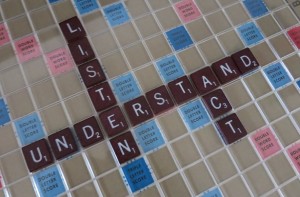Ironically, I want to get to the point with this series of articles.
This post is #1 in a a group of articles I wrote based on a presentation I gave to the Public Relations Insitute of Australia on “How To Make Your Audience Listen Better.” The Introduction to the series is here.
If you want to help your audience listen better to you, help them understand why.
As quickly as possible, get to the point by telling the audience one or all of the following:
- The long-term purpose of your presentation. “I’m speaking today so we can help increase revenue for this division, by implementing Project ABC.”
- The short-term objective of today’s discussion. “My task during the next 60 minutes is to give you the rationale why Project ABC is better than the alternatives, and to answer your questions about the service, roll-out and budget.”
- The explicit action you want the audience to do (or less so, to consider) at the end of your allotted time. “At the end of our meeting, I want your approval of Project ABC so we can begin implementation.”
It helps the audience listen when you get to the point quickly because it gives them:
- Focus (it’s about this, not that – no confusion about the topic)
- Intent (why this important now – no vagueness of timing)
- A Plan of Action (specific steps or actions – no uncertainty about what happens when)
Think about it. Remember that time someone was talking and talking, and you had no idea why? How quickly did you tune out? Or even if you tried to listen – bless your heart – what’s the chance that you’d both agree on what’s been said?
Give the Audience the Purpose First, Not Last
So many people in my workshops believe they should put the key messages at the end of the presentation, as if it was the moral of the story.
Put yourself in the audience’s shoes. How long would you sit and listen if you were either unclear or confused about the purpose of the presentation?
On average, most people say they’d give the speaker no more than 3-4 minutes before they tuned out. Or worse, they’d also start making decisions about the speaker’s credibility.
Whatever your over-arching message, the statement should come out of your mouth as naturally and genuinely as soon as possible. It should be explicit and concise. You say it aloud, and it should be reflected on the screen or in the hand-outs.
If there’s no physical presentation involved, the purpose-objective-action should be in the opening paragraph, the executive summary or situation analysis at the top of the document.
Speak From Their Point-of-View, Not Yours
The only way to make a topic relevant is to tell the audience what’s in it for them.
Think about the last date you went on. How interesting was the person who only spoke about themselves? They never asked for your opinion. They never engaged You were merely an audience for their ego. It’s hilarious the same principle is true between speaker and audience.
Always talk about their favourite subject: them.
But, be careful of being too overt.
A workshop participant once said the point of his speech was to get the audience to buy his company’s life insurance. “If I stated my objective – to get them to buy insurance – I’d sound bold and crass. My audience won’t listen to a sales pitch,” he said.
I agree 100%. But, his stated objective – to get the audience to buy his product – is about him. It’s not about the audience. How could he say it in a way more relevant to the audience?
Here’s how we reframed the objective.
“I’m speaking today to make sure each of you has adequate life insurance cover. As someone who’s been working in life insurance for the past 15 years, I want to give you my opinion of life insurance, some facts about what most people need, and some tips so you know if you have the right amount of coverage. By the end of the presentation, if you have any questions, thoughts or concerns about your own policies, I hope to either answer those questions here tonight, or I can schedule time with you to review your policies privately.”
See? The same objective is reached, but the true point is clear, concise and transparent at the beginning of the presentation. Who wouldn’t listen now?
Here’s something that’ll tie this article to the next. It’s not hard to get to the point when you’ve put some structure to what you want to say. (Link: the Rule of 3s)
On a side note, if you don’t know why Aristotle is such a big deal, he essentially mapped out this persuasion philosophy some 3,000 years ago. Here’s an overview on Aristotle and his influence on communciations.
How else have you woven into your presentation your key objective or outcome? Please leave your comments below.
This is one in a series of articles about how to help your audience listen better, starting here.


No comment yet, add your voice below!